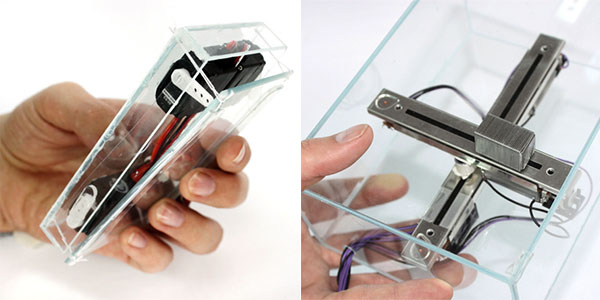For her final in a college level sign language class, student Anna put together this adorable rendition of Cee-Lo Green’s catchy tune “F–k You.” Girl’s got skillz, yo. (Warning: Contains NSFW language)
[Via @kpereira]
For her final in a college level sign language class, student Anna put together this adorable rendition of Cee-Lo Green’s catchy tune “F–k You.” Girl’s got skillz, yo. (Warning: Contains NSFW language)
[Via @kpereira]
PhD student Fabian Hemmert asks, “How can we make digital content graspable for us, for humans?” How do we get from the physical to the digital? He introduces three conceptual cell phone models (“mobile-shaped phone boxes,” really) that could theoretically help bridge this gap that has yet to be conquered. The “weight-shifting mobile” uses a iron weight that moves around, giving the user a sense of physical mass. For example, when you’re exploring your way through a city using Google Maps, the weight can direct you in the right direction as it shifts the center of gravity inside the phone, making you feelwhich way to turn. Next up is the “shape-changing mobile.” Say you have a wide collection of eBooks on your device. If you’re reading a short twenty page story, the device will make itself thin; if you’re reading a lengthy Harry Potter novel, the device will expand, making the experience more realistic, as if you were holding a thick book. It can also change it’s shape to customize the grasp, have the device lean towards you when in use, etc. The “living mobile phone” is downright strange: this model has a “breath” and “heartbeat.” It’s meant to make the device seem organic in your pocket. In standby mode, the phone “breaths” up and down; when you receive an alert, it’s “heart rate” increases and the up and down motions speed up. To calm it down? “Pat it behind the ears.”

Hemmert’s ideas are innovative andinteresting, though I feel the implementation of such technologies will remain far-out research assignments for the forseeable future. He ends the demonstration with this postulation: “Not humans should get more technical in the future; rather than that, technology a bit more human.” Intriguing, intellectual, and plain ‘ol creepy if you ask me.
[Via InformationAesthetics; Engadget]
Parsons student Ryan Raffa crafted a do-it-yourself music controller with an ADXL 335 accelerometer and an Arduino board that communicates serially with Max MSP. In simpler terms he created a small device that has five embedded tracks and a sixth button that applies a delay on those tracks; pushing the buttons plays the various tracks and moving the device around slows down and speeds up the beat thanks to the built-in accelerometer. (An accelerometer is the device installed in iPhones and other gadgets that allows users to swap from vertical to landscape views just by changing the orientation of the device.) Check out Ryan’s final product in the video above. I think it’s safe to say he received an “A” for his final class project.
[Via Engadget]
Watch what happens when a modern day student brings a typewriter to class. Give the kid a break, at least he’s taking notes!
[Via Gizmodo]
The Contortionist was created by Dominic Hargreaves, a 24-year-old student from London. The idea to make a collapsable bike came easy to him: “I couldn’t find a folding bicycle I liked. I wanted something that could take a bit of punishment and that you could have fun with. So I made one myself.” He is in talks with manufacturers about getting this concept idea onto shelves in the near future. Check out the video above to see how it works.

What’s the secret behind artist Sarah Watson and her ‘invisible car?’ “The University of Central Lancashire artist made the incredible optical illusion by spray painting a battered Skoda Fabia to match the car park[ing lot] and entrance to her art studio.”
Check out another image of this surreal illusion and a link to the short source article that explains this form of art “reminiscent of the work of pavement artist Julian Beever.”